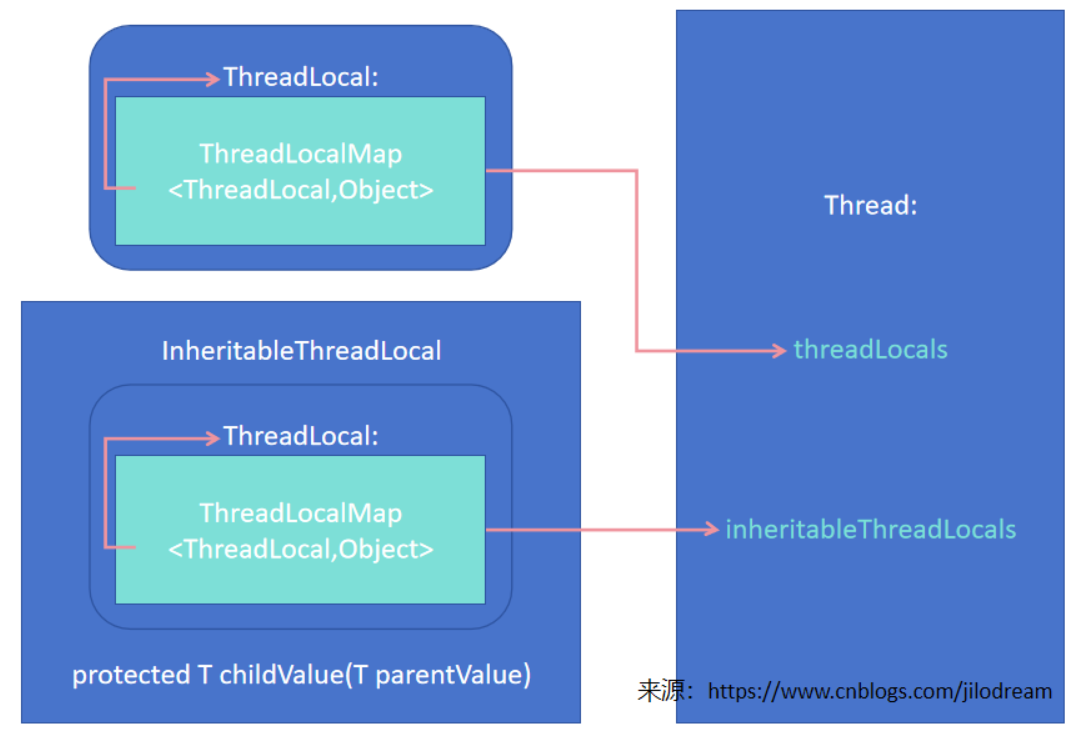在前文中我们讲过ThreadLocal,相当于是每个线程有一个小书包,线程之间的小书包是隔离的,只存放了属于当前线程自己的变量,因此不会发生数据安全的问题。
(前文博客浅谈ThreadLocal----每个线程一个小书包 https://www.cnblogs.com/jilodream/p/19118986)
但是有时任务太繁重时,父线程希望new出新的子线程来为自己的业务提供帮助,同时希望子线程在处理时,也能用到自己保存在ThreadLocal中的变量。
现在有三种办法:
(1)直接把父线程的ThreadLocalMap传递给子线程,让子线程直接拿去用
如:
sonThread.threadLocals=parent.threadLocals
(2)父线程在创建子线程时将子线程需要用到的ThreadLocal数据,专门指定。
如:
Thread sonThread=new Thread(new Runnable() {@Overridepublic void run() {threadLocal1.set(xxx1); //手动指定threadLocal2.set(xxx2); //手动指定threadLocal3.set(xxx3); //手动指定 }});
(3)将父线程中threadLocals 中的数据,打包整理后,统一传递给子线程。
第一种显然不行,如果两者指向了相同的Map 会导致缓存数据被共享,父子线程存在并发读写,又会导致安全问题。
方法二虽然灵活,但是指定起来过于繁琐,每个子线程都要单独设置一遍。
java选用的是方法三,但是实现起来稍有不同:
java 定义了一个InheritableThreadLocal类。通过这个类来实现线程可继承的ThreadLocal
定义中的:
Inheritable [ɪn'herɪtəbl]
adj. 可继承的,会遗传的
InheritableThreadLocal指可以继承/遗传的ThreadLocal。接下来看源码:
在Thread类中,定义了以下属性:
ThreadLocal.ThreadLocalMap inheritableThreadLocals = null;
类似于thread.threadLocals,这是给InheritableThreadLocal 来存储可以继承的属性的Map。
InheritableThreadLocal类的源码,它继承了ThreadLocal:
public class InheritableThreadLocal<T> extends ThreadLocal<T> {/*** Creates an inheritable thread local variable.*/public InheritableThreadLocal() {}/*** Computes the child's initial value for this inheritable thread-local* variable as a function of the parent's value at the time the child* thread is created. This method is called from within the parent* thread before the child is started.* <p>* This method merely returns its input argument, and should be overridden* if a different behavior is desired.** @param parentValue the parent thread's value* @return the child thread's initial value*/protected T childValue(T parentValue) {return parentValue;}/*** Get the map associated with a ThreadLocal.** @param t the current thread*/ThreadLocalMap getMap(Thread t) {return t.inheritableThreadLocals;}/*** Create the map associated with a ThreadLocal.** @param t the current thread* @param firstValue value for the initial entry of the table.*/void createMap(Thread t, T firstValue) {t.inheritableThreadLocals = new ThreadLocalMap(this, firstValue);} }
通过源码我们可以发现,它的用法和实现与ThreadLocal基本相同,但是它重写了父类(ThreadLocal)的几个方法:
(1)
首先是getMap(),重写的目的是当需要操作map对象时,(防盗连接:本文首发自http://www.cnblogs.com/jilodream/ )请使用inheritableThreadLocals而不是再是父类中的t.threadLocals写法,这样所有使用的map就都切换到了
ThreadLocal.ThreadLocalMap inheritableThreadLocals这个属性上来了。
(2)
其次是createMap() 方法,该方法的主要目的是初始化Map对象
这里强调了初始化的是 t.inheritableThreadLocals 属性。为啥没直接用getMap() 方法来获取 t.inheritableThreadLocals呢?这是由于 t.inheritableThreadLocals 还没有初始化,返回是null,你调用getMap()没有意义。
(3)
最后是 childValue() 方法,它是指当发生继承动作时,父类中的存储的变量转化为子类对象的转化转换。这里直接抽象成方法了,方便大家重写自己的InheritableThreadLocal类时,可以直接重写该方法。
如我们想前边加一个标签,代表是子线程专用,亦或者进行翻译转换等等,总之方便你自己实现转换。
来看下继承动作具体是怎么操作的:
继承主要发生在主线程创建子线程程时,我们来看下Thread的构造方法源码,经过一堆跳转最后会跳转进这个方法:
private Thread(ThreadGroup g, Runnable target, String name,long stackSize, AccessControlContext acc,boolean inheritThreadLocals) {//....if (inheritThreadLocals && parent.inheritableThreadLocals != null)this.inheritableThreadLocals =ThreadLocal.createInheritedMap(parent.inheritableThreadLocals);/* Stash the specified stack size in case the VM cares */this.stackSize = stackSize;/* Set thread ID */this.tid = nextThreadID();}
方法参数中的boolean inheritThreadLocals表示是否要继承/遗传。手动创建的线程,这里都会是true,代表要继承/遗传。
parent.inheritableThreadLocals != null 判断父线程的inheritableThreadLocals 属性是否为null (是否初始化了),如果不为null(父线程有需要遗传的本地变量),才发生遗传动作。
条件都满足则发生遗传,(防盗连接:本文首发自http://www.cnblogs.com/jilodream/ )入参为父线程的遗传本地变量,也就是属性inheritableThreadLocals。
之后进入ThreadLocalMap的构造方法,开始构造子线程的inheritableThreadLocals 属性:
private ThreadLocalMap(ThreadLocalMap parentMap) {Entry[] parentTable = parentMap.table;int len = parentTable.length;setThreshold(len);table = new Entry[len];for (Entry e : parentTable) {if (e != null) {@SuppressWarnings("unchecked")ThreadLocal<Object> key = (ThreadLocal<Object>) e.get();if (key != null) {Object value = key.childValue(e.value);Entry c = new Entry(key, value);int h = key.threadLocalHashCode & (len - 1);while (table[h] != null)h = nextIndex(h, len);table[h] = c;size++;}}}}
方法中就是遍历父线程的Map生成子线程自己的Map.Entry 了。
这里注意,在获取Entry的key 时,通过entry.get() 拿到父线程的Map 的key的弱引用,强制转化为ThreadLocal类型即可。
在获取value 值时,调用的是key的childValue()方法,也就是InheritableThreadLocal.childValue()中重写的方法,将父线程的value值转为子线程的value时。
这样子线程中:
1、map初始化好了;
2、entry元素也通过父线程都转移到子线程中了;
3、获取的遗传map,使用的都是遗传map了。(通过getMap()重写)
map的get set remove 等核心逻辑都直接使用父类的逻辑。(因为InheritableThreadLocal继承自ThreadLocal,并且没有重写这段逻辑)
总体上了来说,ThreadLocal,InheritableThreadLocal的实现都非常的优雅,不但很好的利用了对象的继承,保证用户在使用时无感知的发生了继承。其次用户在自定义自己的InheritableThreadLocal class时,(防盗连接:本文首发自http://www.cnblogs.com/jilodream/ )也只需要完成如何转化即可。非常值得我们自己在设计类结构和关系时参考这里的细节设计。
类关系整体的结构如下:

除此之外,我们也可以通过源码发现InheritableThreadLocal的一个特性,就是属性的遗传来自于父InheritableThreadLocal的全量属性,是不能根据某个线程自定义的。
并且在遗传时,子线程是在被new出实例时,就已经获得了此刻全部的属性,如果父线程后续调整了InheritableThreadLocal的范围,子线程是感知不到的。
来看这样一个例子即可:
public static void main(String[] args) {ThreadLocal<String> tl1 = new InheritableThreadLocal<>();ThreadLocal<String> tl2 = new InheritableThreadLocal<>();ThreadLocal<String> tl3 = new InheritableThreadLocal<>();tl1.set("t1");tl2.set("t2");Thread sonThread = new Thread(new Runnable() {@Overridepublic void run() {String s1 = tl1.get();String s2 = tl2.get();String s3 = tl3.get();System.out.println("out:" + s1);System.out.println("out:" + s2);System.out.println("out:" + s3);}});tl2.set("newTl2Value");sonThread.start();}
输出如下,所有的值都是在new 子线程时就已经发生了,而并不是在子线程start之前:
out:t1 out:t2 out:null
